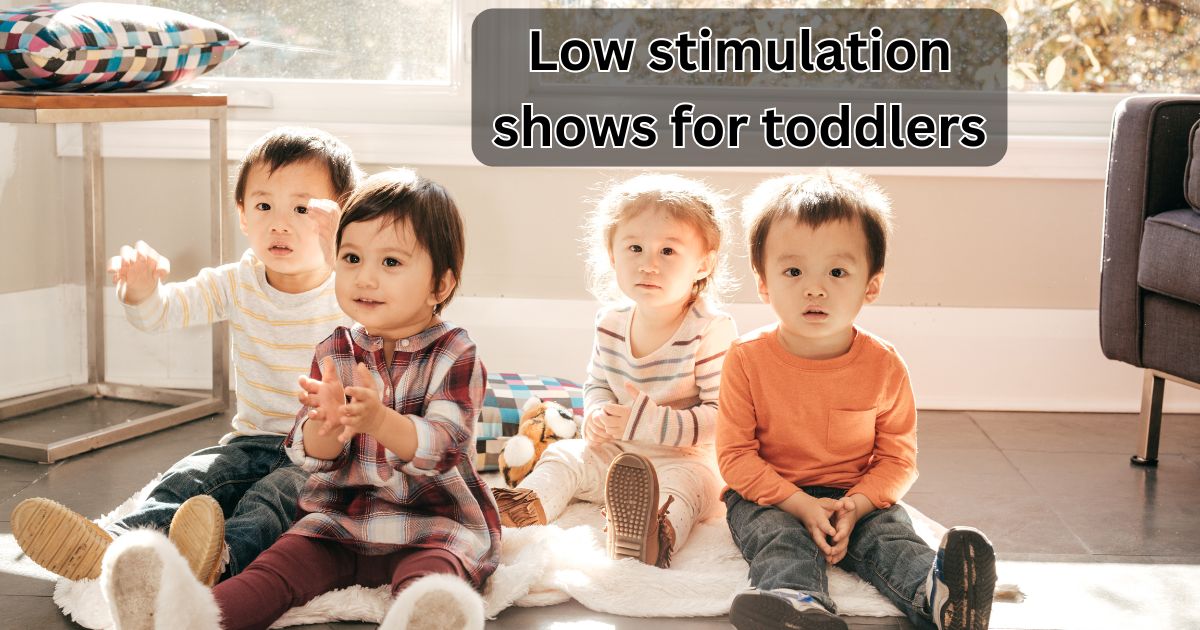In the digital age, finding suitable content for toddlers can be challenging for parents. Among various types of programming, low stimulation shows for toddlers are gaining popularity due to their gentle approach, designed to support young children’s development. These shows, characterized by their calm and soothing nature, are specifically crafted to avoid overwhelming sensory inputs such as rapid scene changes, bright colors, and loud sounds. Understanding the role and benefits of low stimulation shows for toddlers can help parents make informed decisions about what their toddlers watch.
Low stimulation shows for toddlers are essential for children who are still developing their sensory processing abilities. Unlike traditional children’s programming, which often features high energy and fast-paced visuals, low stimulation shows for toddlers offer a slower, more measured pace. This approach helps minimize overstimulation, which can be particularly important for children with sensitive temperaments or those who easily become overstimulated. By choosing appropriate content, parents can create a more balanced and nurturing viewing experience for their little ones.
Why Toddlers Need Low Stimulation Shows
Toddlers are in a crucial stage of development where their sensory systems are rapidly evolving. High stimulation shows, with their bright colors, rapid scene changes, and loud sounds, can sometimes overwhelm a young child’s developing brain. This overstimulation can lead to difficulties in focus, increased irritability, and disrupted sleep patterns. Low stimulation shows provide a counterbalance, offering content that is gentle and calming, which can be beneficial in managing these issues.
Low stimulation shows contribute to better emotional regulation and cognitive development by creating a more serene viewing environment. The slower pace and soft visuals help toddlers process information at a comfortable rate, reducing the likelihood of sensory overload. By incorporating such shows into daily routines, parents can help their children develop healthy viewing habits and support their overall well-being, making these shows an excellent choice for promoting a positive media experience.
Characteristics of Low Stimulation Shows
Low stimulation shows are distinguished by several key characteristics designed to minimize sensory overload. Firstly, these shows feature minimal rapid scene transitions and a more deliberate pacing, allowing toddlers to engage with the content without feeling rushed. Additionally, the color palette used in these shows is typically subdued, avoiding overly bright or flashing lights that can be jarring to young viewers.
Sound design in low stimulation shows is also carefully crafted to be soothing and non-intrusive. Background music is gentle and calming, avoiding sudden loud noises or abrupt changes in volume. Narration is soft and clear, providing a comforting tone that enhances the overall calming effect. By focusing on these aspects, low stimulation shows create a supportive viewing environment that aligns with the developmental needs of toddlers.
How to Identify Low Stimulation Shows for Toddlers
Identifying low stimulation shows involves looking for several telltale signs that the content is appropriate for young children. One of the primary indicators is the pacing of the show; low stimulation programs typically have a slower, more deliberate pace with fewer rapid scene changes. This helps maintain a calm atmosphere and allows toddlers to follow along without becoming overstimulated.
Another important factor is the visual and auditory elements of the show. Look for content that uses soft, muted colors rather than bright, flashy visuals. The sound design should be gentle and consistent, without sudden loud noises or jarring sound effects. By focusing on these characteristics, parents can select shows that provide a soothing and appropriate viewing experience for their toddlers.
Top 10 Low Stimulation Shows for Toddlers
Here are ten highly recommended low stimulation shows that are ideal for toddlers:
- “Bluey” – This Australian series features gentle stories about a blue heeler puppy and her family. The show’s calm pacing and simple narratives make it perfect for toddlers.
- “Daniel Tiger’s Neighborhood” – With its soft colors and soothing music, this show teaches emotional intelligence through gentle storytelling.
- “Puffin Rock” – Set on a tranquil island, this series follows a young puffin and her friends, offering a calming viewing experience.
- “Sarah & Duck” – This British show features slow-paced adventures of a young girl and her duck friend, presented in a gentle and soothing manner.
- “Tumble Leaf” – The show’s soft visuals and gentle storyline about a fox exploring his world make it ideal for toddlers.
- “Hey Bear Sensory” – Designed specifically for sensory development, this show uses soothing visuals and calming music to engage young viewers.
- “Sesame Street” (Select Episodes) – Certain episodes of this classic show offer a slower pace and gentle content suitable for toddlers.
- “Little Bear” – This show’s simple stories and calm narration provide a peaceful viewing experience.
- “The World of Peter Rabbit and Friends” – Based on Beatrix Potter’s stories, this show features gentle animations and soothing narration.
- “Kipper” – The gentle adventures of Kipper the dog are perfect for a calming viewing experience.
These shows provide a variety of gentle, engaging content that supports toddlers’ developmental needs while offering a soothing viewing experience.
The Impact of Low Stimulation Shows on Toddler Sleep
Many parents notice improvements in their toddlers’ sleep patterns when incorporating low stimulation shows into their routines. The calming nature of these shows helps to prepare toddlers for sleep by reducing overstimulation before bedtime. By choosing gentle, slow-paced content in the evening, parents can create a relaxing pre-sleep environment that supports better sleep quality.
Studies suggest that screen time, particularly with high stimulation content, can negatively impact sleep. Low stimulation shows, with their soothing visuals and calming music, offer a healthier alternative. This type of content helps toddlers wind down and transition more smoothly from the day’s activities to a restful night’s sleep. Implementing these shows as part of a bedtime routine can contribute to more consistent and peaceful sleep for young children.
Comparing Low Stimulation Shows with Traditional Children’s Programming
Traditional children’s programming often features vibrant colors, rapid scene changes, and high-energy music, which can be overwhelming for toddlers. In contrast, low stimulation shows are designed to offer a slower pace, gentle visuals, and calming sounds. This difference in approach helps to minimize sensory overload and supports a more balanced viewing experience.
While traditional shows can be engaging and educational, they may not always align with the sensory needs of young children. Low stimulation shows, on the other hand, focus on creating a soothing environment that promotes relaxation and supports developmental needs. By comparing these types of content, parents can make more informed choices about what to include in their toddlers’ media diets.
Parental Controls and Content Selection
To ensure that toddlers are exposed to appropriate content, parental controls and content selection tools are essential. Many streaming services and television platforms offer parental control features that allow parents to filter and select shows based on their suitability for young viewers. These tools can help parents curate a collection of low stimulation shows that meet their child’s needs.
In addition to using parental controls, parents can actively review and select shows that align with their preferences for low stimulation content. By paying attention to show descriptions, ratings, and reviews, parents can make informed decisions about what their toddlers watch. Combining these strategies ensures that children are exposed to content that is both developmentally appropriate and enjoyable.
Incorporating Low Stimulation Shows into Daily Routines
Integrating low stimulation shows into daily routines requires thoughtful planning to balance screen time with other activities. It is beneficial to schedule these shows during times when toddlers need a calming break, such as after nap times or before bedtime. Establishing a consistent routine helps toddlers anticipate and adapt to their screen time in a healthy way.
Balancing screen time with interactive and physical activities is also crucial. While low stimulation shows can provide valuable downtime, they should complement other aspects of a toddler’s day, such as playtime, outdoor activities, and social interactions. This balanced approach supports overall development and ensures that screen time remains a positive and enriching part of a toddler’s routine.
The Role of Low Stimulation Shows in Early Childhood Education
Low stimulation shows for toddlers can play a supportive role in early childhood education by providing gentle, age-appropriate content that aligns with educational goals. Many of these shows incorporate foundational concepts such as social skills, emotional regulation, and basic problem-solving in a calm and accessible manner. For example, shows like “Daniel Tiger’s Neighborhood” offer valuable lessons about emotions and social interactions through soothing narratives and relatable characters. By incorporating low stimulation shows for toddlers into educational routines, parents can enhance their child’s learning experience while ensuring that the content remains engaging and developmentally appropriate.
Common Misconceptions About Low Stimulation Shows
There are several misconceptions about low stimulation shows that can lead to misunderstandings among parents. One common myth is that these shows are less educational compared to their high-stimulation counterparts. However, many low stimulation shows are designed with educational content in mind, providing valuable lessons in a gentle format.
Another misconception is that low stimulation shows are only suitable for children with sensory sensitivities. In reality, these shows can benefit all toddlers by offering a balanced and calming viewing experience. By addressing these myths and understanding the true benefits of low stimulation content, parents can make more informed choices about what their children watch.
Also Read: What Does CFS Mean on Instagram
Tips for Introducing Low Stimulation Shows to Toddlers
Introducing low stimulation shows to toddlers can be done smoothly by gradually transitioning from high stimulation content. Start by incorporating short segments of low stimulation shows into the daily routine, gradually increasing the time as the child becomes accustomed to the new format.
Engaging toddlers with these shows can also involve interactive elements, such as discussing the story or asking questions about the characters. This helps maintain interest while promoting cognitive development. By introducing low stimulation content thoughtfully, parents can create a positive and enjoyable viewing experience for their toddlers.
The Science Behind Low Stimulation and Toddler Brain Development
Research into the impact of low stimulation on toddler brain development highlights the benefits of a calm and measured viewing experience. Studies indicate that excessive sensory input can disrupt cognitive processing and emotional regulation in young children. Low stimulation shows offer a more balanced approach, supporting healthy brain development by reducing sensory overload.
Expert insights emphasize that early childhood is a critical period for sensory processing development. By choosing content that aligns with a toddler’s developmental needs, parents can support optimal cognitive and emotional growth. The science behind low stimulation shows underscores the importance of mindful media consumption in promoting a child’s overall well-being.
Low Stimulation Shows as a Tool for Calming Anxious Toddlers
For toddlers who experience anxiety or stress, low stimulation shows can serve as an effective calming tool. The gentle pacing and soothing elements of these shows help to create a calming environment that can reduce anxiety and provide comfort during stressful moments.
Using low stimulation shows strategically, such as during transitions or before bedtime, can help manage anxiety and promote relaxation. Techniques for incorporating these shows into daily routines can further support toddlers in developing coping mechanisms and achieving emotional stability.
The Role of Parents in Moderating Low Stimulation Content
Parents play a crucial role in moderating low stimulation content to ensure that it meets their child’s needs. Active co-viewing and discussion about the content can enhance the viewing experience, making it more interactive and engaging. Parents can also model appropriate screen time behaviors and discuss the themes and lessons presented in the shows.
Setting boundaries around screen time and incorporating low stimulation shows as part of a balanced routine is essential. By actively participating in their child’s media consumption and making informed choices, parents can create a positive and supportive viewing environment that aligns with their child’s developmental needs.
Customizing Low Stimulation Content for Different Age Groups
Selecting low stimulation shows based on a toddler’s age and developmental stage ensures that the content is appropriate and engaging. Younger toddlers may benefit from shows with simple narratives and gentle visuals, while older toddlers might enjoy content with slightly more complex themes but still presented in a calming manner.
Tailoring content to different age groups helps support developmental milestones and keeps toddlers engaged. By choosing shows that align with their child’s age and interests, parents can provide a more enriching and supportive media experience.
Success Stories: Real-Life Examples of Toddlers Thriving with Low Stimulation Shows
Many parents have reported positive outcomes from incorporating low stimulation shows into their toddlers’ routines. For instance, parents have observed improvements in their child’s sleep patterns, emotional regulation, and overall behavior when switching to gentler content.
These success stories highlight the benefits of low stimulation shows and offer encouragement for other parents considering this approach. Testimonials and real-life examples provide valuable insights into how low stimulation content can positively impact a toddler’s development and well-being.
Alternatives to Screen Time: Balancing Low Stimulation Shows with Other Activities
While low stimulation shows offer valuable benefits, balancing screen time with other activities is essential for a well-rounded routine. Non-screen activities such as outdoor play, reading, and interactive games provide additional opportunities for development and engagement.
Incorporating a variety of activities helps ensure that toddlers receive a balanced media experience while also supporting their physical, cognitive, and social development. By combining screen time with active and interactive experiences, parents can create a more holistic and enriching environment for their children.
FAQs
Q: Are low stimulation shows suitable for all toddlers?
A: Yes, low stimulation shows are beneficial for all toddlers, as they offer a calming and supportive viewing experience that can help manage sensory overload and promote relaxation.
Q: How long should toddlers watch low stimulation shows each day?
A: It’s important to balance screen time with other activities. Experts recommend limiting screen time to about one hour per day for toddlers, with low stimulation shows being a suitable choice for part of that time.
Q: Can low stimulation shows replace other forms of learning and play?
A: Low stimulation shows can complement other forms of learning and play but should not replace them. They are best used as part of a balanced routine that includes interactive and physical activities.
Conclusion
Low stimulation shows for toddlers offer a valuable alternative to high-energy programming, supporting a more balanced and nurturing viewing experience. By choosing content that aligns with their child’s developmental needs, parents can help manage sensory overload, promote better sleep, and support overall well-being. Integrating these shows thoughtfully into daily routines, alongside other engaging activities, creates a holistic approach to media consumption that benefits toddlers’ growth and development.










